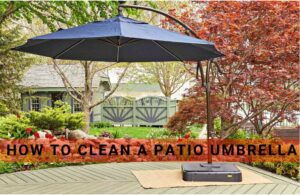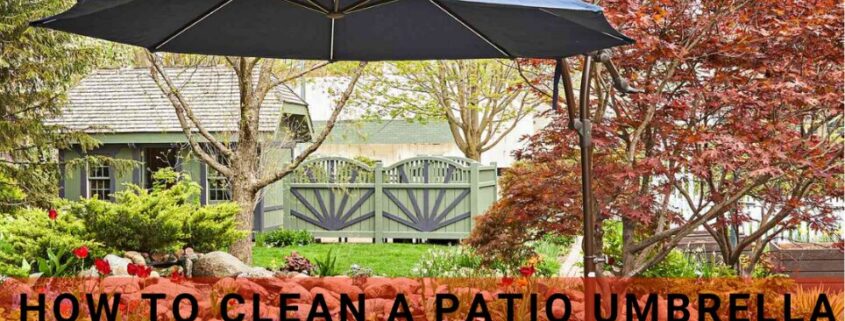A patio umbrella is a delightful addition to any outdoor space, providing shade and enhancing the overall aesthetic. However, with exposure to the elements, it’s not uncommon for these umbrellas to accumulate dirt, mold, and stains over time. In this guide, we’ll walk you through the step-by-step process of cleaning your Patio Umbrella to keep it looking fresh and prolong its lifespan.

Impact of Weather Conditions on Regular Activities
Sun Damage
Fading of Surfaces:
Prolonged exposure to direct sunlight can lead to the fading of various surfaces, including furniture, fabrics, and paint. Regular cleaning helps protect against discoloration and deterioration caused by UV rays.
Material Degradation:
The sun’s intense heat can accelerate the breakdown of materials, such as plastics, wood, and metal. Routine cleaning not only removes accumulated grime but also allows for the inspection and maintenance of vulnerable surfaces, mitigating the impact of sun damage.
Rain and Mold Growth
Moisture Retention:
Rainfall can result in the accumulation of moisture on outdoor surfaces, creating an environment conducive to mold and mildew growth. Regular cleaning helps prevent the retention of excess moisture, reducing the likelihood of mold-related issues.
Structural Integrity:
Continuous exposure to rain can compromise the structural integrity of outdoor elements, such as decks, patios, and roofing. Cleaning surfaces regularly helps identify and address vulnerabilities before they escalate, preserving the longevity and functionality of these structures.
Extend Patio Umbrella Lifespan: Fabric Care Tips
Fabric Type and Care Instructions
Selection of Durable Fabrics: Choosing high-quality, weather-resistant fabrics for your patio umbrella can significantly impact its longevity. Opt for materials designed to withstand UV rays, moisture, and other environmental factors.
Regular Cleaning Routine: Different fabric types require specific cleaning methods. Consult the care instructions provided by the manufacturer and establish a regular cleaning routine to remove dirt, stains, and prevent mold or mildew growth. This not only enhances the umbrella’s appearance but also contributes to its overall durability.
UV Protection and Fade Resistance: Ensure that the chosen fabric offers UV protection and fade resistance. This safeguards the umbrella from the harmful effects of prolonged sun exposure, preventing color fading and material degradation over time.
Frame Material Considerations
Rust-Resistant Materials: Opt for patio umbrella frames made from rust-resistant materials such as aluminum or stainless steel. This helps prevent corrosion, especially in regions with high humidity or frequent exposure to rain.
Inspection and Maintenance: Regularly inspect the frame for any signs of wear, rust, or loose components. Addressing issues promptly through routine maintenance can extend the lifespan of the umbrella by preventing more significant structural problems.
Storage Practices: During periods of non-use, consider storing the umbrella in a protective cover or in a designated storage area. This safeguards the frame from harsh weather conditions and reduces the risk of damage during inclement weather.
Tips for Using Outdoor Umbrella Cleaners Safely
Selecting Suitable Cleaners: When cleaning Outdoor Umbrella, choose mild and non-abrasive cleaners that are specifically formulated for the umbrella’s material. Avoid harsh chemicals that may damage the fabric or compromise its water and UV resistance.
Testing in Small Areas: Before applying any cleaner to the entire umbrella, test it in a small, inconspicuous area to ensure compatibility and to avoid potential discoloration or damage. This precautionary step helps identify any adverse reactions before full-scale cleaning.
Gentle Cleaning Techniques: Use a soft sponge or cloth to gently clean the umbrella surface. Avoid scrubbing vigorously, as this can damage the fabric or alter its texture. Patience and a gentle touch are key to preserving the integrity of the umbrella material.
Rinsing Thoroughly: After applying the cleaner, thoroughly rinse the umbrella with clean water to remove any residual cleaning solution. Residue left on the fabric can attract dirt and contribute to faster wear and tear.
Sun Garden Umbrella: Tips for Specific Care:
Features of a Sun Garden Umbrella
Tilt and Rotation Mechanisms: Many Sun Garden umbrellas come with tilt and rotation features, allowing you to adjust the angle of the canopy to follow the sun’s movement. Familiarize yourself with these mechanisms to maximize the umbrella’s effectiveness in providing shade.
Wind Ventilation: Sun Garden umbrellas often include wind vents in their canopies. These vents enhance air circulation, reducing wind resistance and minimizing the risk of the umbrella being lifted or damaged during windy conditions.
Sun Protection and UV Resistance
UV-Blocking Fabric: Sun Garden umbrellas typically use fabrics designed to block harmful UV rays effectively. Check the UV protection rating of the fabric, and choose an umbrella with a high UPF (Ultraviolet Protection Factor) to ensure optimal sun protection for you and your outdoor space.
Regular Inspection for Sun Damage: Periodically inspect the umbrella for signs of sun damage, such as fading or weakening of the fabric. Address any issues promptly to maintain the umbrella’s sun protection capabilities.
Cleaning and Maintaining Sun Garden Umbrellas
Regular Dusting and Shaking: Dust and debris can accumulate on the umbrella’s surface. Regularly shake out the fabric and use a soft brush or cloth to remove loose dirt. This simple maintenance routine helps prevent the buildup of grime over time.
Storage Practices: When not in use, consider storing the Sun Garden umbrella in a protective cover or in a designated storage area. This shields it from prolonged exposure to the sun and other elements, extending its lifespan.
Periodic Lubrication: If your Sun Garden umbrella has moving parts, such as tilt and rotation mechanisms, apply a suitable lubricant periodically to ensure smooth operation and prevent wear.
Air-Drying in the Proper Position
Gentle Drying: After cleaning your outdoor umbrella, it is crucial to allow it to air-dry thoroughly. Choose a sunny and breezy day for optimal drying conditions. Avoid using heat sources such as hairdryers or direct sunlight for an extended period, as excessive heat may damage the fabric.
Open Canopy for Ventilation: While drying, open the umbrella canopy to promote better air circulation. This helps prevent the growth of mold or mildew and ensures that every part of the umbrella dries evenly.
Proper Positioning: Ensure the umbrella is positioned in such a way that both the top and underside of the canopy receive adequate airflow. This practice facilitates a more effective drying process and contributes to maintaining the umbrella’s overall cleanliness.
Special Consideration: Outdoor Umbrella Cleaner
Introduction to Outdoor Umbrella Cleaners
Purpose and Benefits: Outdoor umbrella cleaners are specially formulated to tackle the unique challenges of umbrella fabrics. They help remove dirt, stains, and environmental residue, contributing to the preservation of the umbrella’s appearance and longevity.
Types of Cleaners: Outdoor umbrella cleaners come in various types, including sprays, concentrated solutions, and wipes. Understanding the specific needs of your umbrella material can guide you in choosing the most suitable cleaner for effective and safe use.
Choosing the Right Cleaner for Your Umbrella
Fabric Compatibility: Different umbrella fabrics require different cleaning solutions. Check the manufacturer’s recommendations and choose a cleaner that is compatible with the specific material of your umbrella to avoid any adverse reactions or damage.
Mild and Environmentally Friendly Options: Opt for cleaners that are mild and environmentally friendly. Harsh chemicals can compromise the integrity of the fabric and may have negative environmental impacts. Choosing a gentle yet effective cleaner ensures the longevity of both your umbrella and the surrounding ecosystem.
Application and Effectiveness
Follow Manufacturer’s Instructions: Read and follow the application instructions provided by the cleaner’s manufacturer. Proper application ensures the cleaner’s effectiveness and minimizes the risk of damage to the umbrella.
Test in Small Areas: Before applying the cleaner to the entire umbrella, test it in a small, inconspicuous area. This helps determine its compatibility with the fabric and ensures that it achieves the desired cleaning results without causing harm.
Multiple Applications for Stubborn Stains: For stubborn stains, consider multiple applications of the cleaner, allowing each application to dry completely before proceeding. This gradual approach can be more effective than attempting to remove tough stains in a single application.
Conclusion:
Maintaining a clean patio umbrella not only enhances the visual appeal of your outdoor space but also ensures its durability. Regular cleaning, proper care, and the use of outdoor umbrella cleaners can go a long way in preserving the beauty and functionality of your patio umbrella.
FAQs:
Can I use bleach to clean my patio umbrella?
It’s not recommended, as bleach can weaken the fabric and cause discoloration. Stick to mild detergents or specialized outdoor umbrella cleaners.
How often should I clean my patio umbrella?
Cleaning frequency depends on factors like weather conditions and usage. A general rule is to clean it at least twice a season and before storing it for the winter.
Can I machine wash my patio umbrella canopy?
Most patio umbrella canopies are not machine washable. Hand cleaning with a mild detergent and water is a safer option.
Are there specific cleaners for sun garden umbrellas?
Yes, sun garden umbrellas may have unique cleaning requirements. Consider using cleaners formulated for UV-resistant fabrics to maintain their integrity.
How can I prevent mold growth on my patio umbrella?
Ensure the umbrella is completely dry before storing it. Use a fabric protector to add a layer of resistance against mold and mildew.




Leave a Reply
Want to join the discussion?Feel free to contribute!